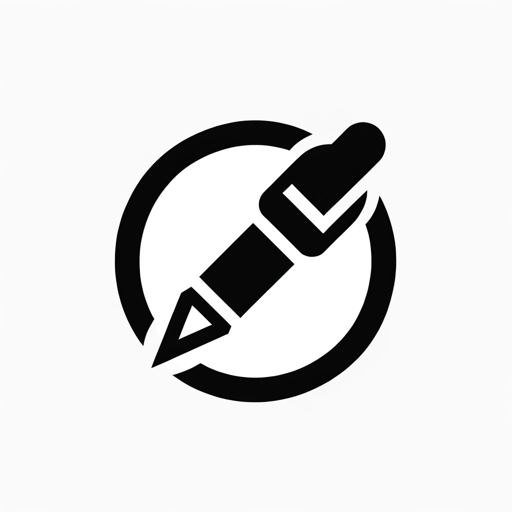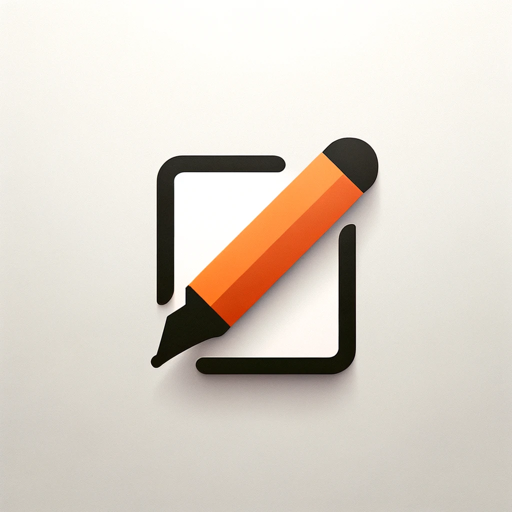Writing Editor-AI-powered scientific editing tool
AI-powered editing for precision writing
Revise this paragraph for accuracy and clarity.
Edit this for medical journal standards.
Improve the grammar in this text.
Make this paragraph clearer and more precise.
Related Tools
Load More
Editing Guru
Your ultimate solution for improving, reviewing, and rewriting texts. ************************************************************************* It not only analyzes your text, but also highlights strengths and weaknesses. Plus, if you desire, it ca

Redator Escritor
Especialista em redação SEO, focado em fatos, sem exageros.

Copy Editor
Editorial assistant for refining columns.

Academic Editor
Friendly editor for clear, precise academic texts with word count focus.

Copy Editor
Designed for academic and publishing professionals. Offers 2 levels of editing: mechanical and substantive. Select one of the conversation starters to begin!

Editorial Assistant
Expert in refining text while preserving original style and nuance.
20.0 / 5 (200 votes)
Overview of Writing Editor
Writing Editor is a specialized tool designed to enhance the clarity, precision, and technical accuracy of scientific writing, particularly in medical and scientific contexts. Its primary purpose is to streamline the editing process, ensuring that manuscripts, research papers, and technical articles meet the high standards of academic and professional publishing. Writing Editor focuses on improving grammar, syntax, and clarity without altering the original intent or tone of the author. The tool is adept at refining language to align with formal writing conventions required in peer-reviewed journals, providing an essential service for researchers, clinicians, and scholars who must convey complex ideas in a clear and accurate manner. For example, consider a researcher submitting a paper to a medical journal. Their manuscript might contain dense, jargon-heavy language that could be unclear to reviewers or non-expert readers. Writing Editor revises these sections to improve readability while retaining scientific rigor. Another scenario could be editing an abstract to ensure it succinctly conveys the main findings, eliminating redundant phrases and improving flow, ensuring that the manuscript meets publication standards.

Core Functions of Writing Editor
Technical Language Precision
Example
A researcher submits a clinical study with complex statistical results and medical terminology. Writing Editor refines the technical language, ensuring clarity without oversimplification.
Scenario
A doctor writing a paper on cardiovascular disease outcomes might have highly specific medical terms. Writing Editor ensures that these terms are used consistently and appropriately while improving overall sentence structure, ensuring both experts and informed readers can comprehend the study.
Grammar and Syntax Optimization
Example
A manuscript is submitted with several grammatical errors, including misplaced modifiers and run-on sentences. Writing Editor corrects these issues while preserving the scientific tone.
Scenario
In a research paper on oncology treatments, there may be long, complex sentences that could confuse readers. Writing Editor restructures these sentences to improve readability without compromising the technical depth of the content.
Clarity Enhancement
Example
An abstract is revised to remove vague language and improve specificity, helping readers quickly understand the research objectives and findings.
Scenario
A pharmacologist submitting a paper on a new drug’s efficacy needs to make sure their abstract is concise and clear. Writing Editor reduces redundancy and strengthens the wording, so the key points are immediately clear to reviewers and readers.
Target User Groups for Writing Editor
Researchers and Academics
Researchers across fields like medicine, biology, and engineering often need to submit papers to peer-reviewed journals. These users benefit from Writing Editor’s ability to ensure that their writing meets the technical standards required by journals. The tool refines their manuscripts, abstracts, and grant proposals for clarity and coherence without altering the scientific content.
Medical Professionals
Doctors, clinicians, and medical researchers writing case studies, clinical trials, or reviews need precision in conveying complex medical information. Writing Editor helps them present their findings in a way that is both technically accurate and readable, ensuring their papers are suitable for publication in medical journals and accessible to their target audience.

How to Use Writing Editor
Step 1
Visit aichatonline.org for a free trial without login, no need for ChatGPT Plus.
Step 2
Submit your scientific article, research paper, or technical document directly into the editor.
Step 3
Specify your editing goals, such as improving technical accuracy, clarity, or grammar in your document.
Step 4
Receive instant feedback and suggestions tailored to your content, with formal, precise language suited for academic or professional standards.
Step 5
Revise your document based on the provided recommendations, ensuring scientific precision and linguistic clarity.
Try other advanced and practical GPTs
Clinical Case Note Composer
AI-powered tool for clinical case notes

Clinical Trials Analyst
AI-powered Clinical Trials Data Analysis

Clinical Medicine Handbook
AI-powered Clinical Medicine Handbook

Injection Molding Troubleshooter v2.0
AI-powered troubleshooting for injection molding defects

institution/retail trader bot.
AI-powered insights for retail and institutional traders

Joi ~ AI girlfriend
AI-powered companionship, anytime, anywhere.

Background Transformer
AI-Powered Background Transformation Tool

Photo Background Editor
AI-Powered Background Editing Made Easy

Change image background
AI-Powered Image Background Changer

Photo Background Remover
AI-Powered Precision in Background Removal

Spanish Translater
AI-powered, accurate Spanish translations.

Spanish Tutor
AI-powered Spanish tutoring for all.

- Academic Writing
- Scientific Research
- Research Reports
- Technical Papers
- Medical Journals
Frequently Asked Questions about Writing Editor
How does Writing Editor improve scientific writing?
Writing Editor ensures technical accuracy, clarity, and correct grammar, transforming your draft into a polished version ready for publication in medical or academic journals.
What type of documents can I submit?
You can submit scientific papers, medical research articles, technical reports, and any content requiring precise, formal language. The tool is optimized for professional and academic documents.
Do I need any special software to use Writing Editor?
No special software is required. Writing Editor is web-based, accessible through any modern browser, and no login or subscription is necessary to start using it.
Can Writing Editor handle complex scientific terminology?
Yes, Writing Editor is designed to handle specialized terminology, ensuring that your scientific concepts are communicated clearly and accurately without oversimplification.
How quickly can I expect feedback on my document?
You receive instant feedback as soon as your document is processed, allowing you to make real-time edits and improvements without delays.